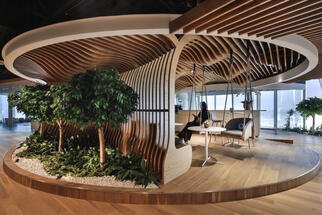Biophilic design incorporates natural elements into the workplace, fostering a connection with nature that enhances employee well-being and productivity. This trend is evident in the increasing use of plants, natural light, and natural materials like wood and stone in office interiors. Green walls and indoor gardens not only beautify the workspace but also improve air quality and create a calming atmosphere.
In addition to biophilic design, the emphasis on employee wellness is transforming office environments. Ergonomic furniture, such as adjustable desks and chairs, supports healthy postures and reduces the risk of work-related injuries. Wellness rooms provide spaces for relaxation, meditation, and mental health support, catering to the holistic needs of employees.
Modern offices are also integrating fitness facilities, such as on-site gyms and yoga rooms, encouraging employees to stay active and maintain a healthy lifestyle. This focus on wellness extends to the design of the overall workspace, with features like improved air quality, natural lighting, and acoustic design to create a comfortable and healthy environment.
Sustainability is another critical aspect of the new office design. Energy-efficient lighting, HVAC systems, and sustainable materials are becoming standard, as companies strive to reduce their environmental footprint. Recycling programs and green certifications, such as LEED, are also gaining popularity, reflecting a commitment to eco-friendly practices.
The future of office spaces lies in creating environments that not only support work but also promote health, well-being, and sustainability. As these trends continue to gain momentum, they are set to redefine what it means to have a modern, forward-thinking office.


